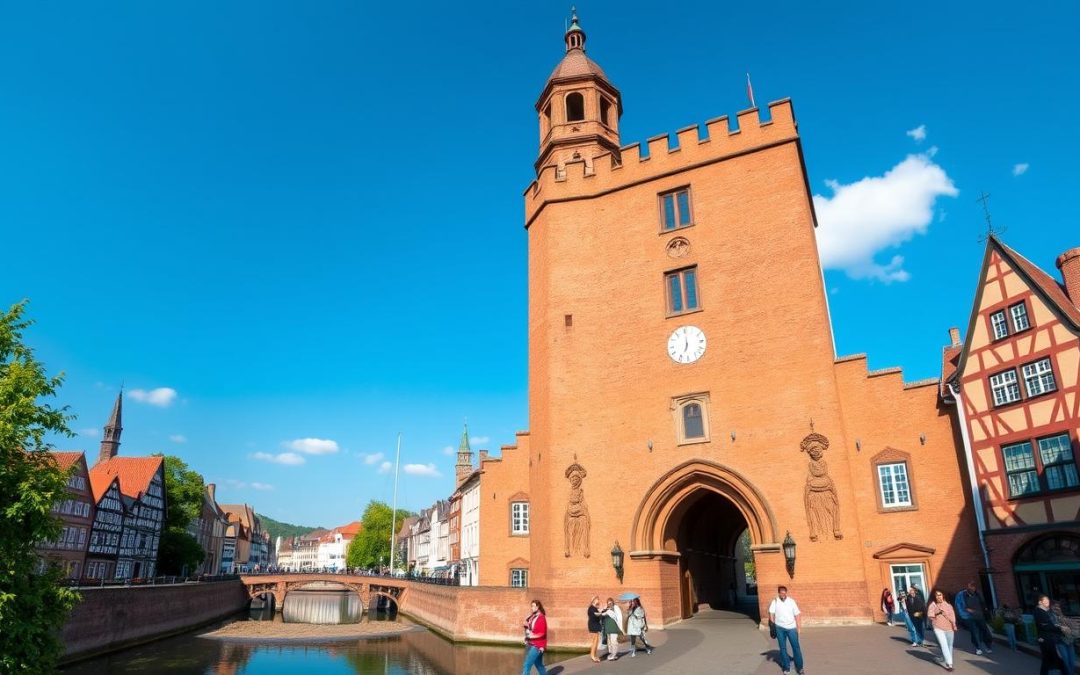Ever wondered about the hidden treasures in a medieval German city? Lübeck is your answer. It’s a UNESCO World Heritage site that offers a journey through time and taste.
Lübeck sits by the Trave River in northern Germany. It’s a mix of old charm and new experiences. With a 4.5 rating, it invites you to walk its medieval streets, see its landmarks, and taste its food.
From the famous Holstentor to the Niederegger marzipan shops, Lübeck has something special for everyone. Whether you love history, architecture, or food, this city will amaze you.
Key Takeaways
- Discover a UNESCO World Heritage Old Town with pristine medieval architecture
- Experience top-rated attractions with consistently high visitor ratings
- Explore iconic landmarks like the Holstentor and St. Mary’s Church
- Indulge in world-renowned Lübeck marzipan and local gastronomy
- Enjoy easy access from Hamburg with convenient transportation options
Discovering the UNESCO Heritage Old Town
Step into Lübeck’s Old Town, a UNESCO World Heritage Site. It takes you back through centuries of medieval history. This place shows Germany’s rich architectural past, inviting you to explore its streets and secrets.
The Lubeck Old Town is like a living museum of medieval urban design. It was once the capital of the Hanseatic League. Here, you’ll see architectural wonders that have lasted for generations.
Medieval Architecture and Historic Streets
Walk through cobblestone streets with Gothic and Renaissance buildings. Each building tells a story of Lübeck’s rich past. The intricate facades show the city’s commercial history.
- Explore narrow alleyways dating back to the 13th century
- Admire preserved medieval merchant houses
- Discover architectural details that reflect historical trading wealth
Notable Merchant Houses and Hidden Courtyards
Lübeck’s UNESCO World Heritage Site is famous for its merchant houses and secret courtyards. These buildings give a peek into the city’s commercial heyday.
| Location Type | Historical Significance | Architectural Features |
|---|---|---|
| Merchant Houses | Hanseatic League Trading Centers | Ornate Brick Facades |
| Hidden Courtyards | Private Trading Spaces | Secluded Architectural Sanctuaries |
Best Photo Spots in the Altstadt
Take pictures of Historic Lubeck’s beauty. The Altstadt has many spots that show off the city’s architecture.
“Every corner of Lübeck tells a story waiting to be discovered and remembered.” – Local Historian
- Holstentor Gate landmark
- Marktplatz central square
- Riverside architectural views
- Medieval street intersections
Your trip through Lübeck’s Old Town is a journey through history, architecture, and culture. It’s an experience you won’t forget.
The Iconic Holstentor: Gateway to Medieval Lubeck
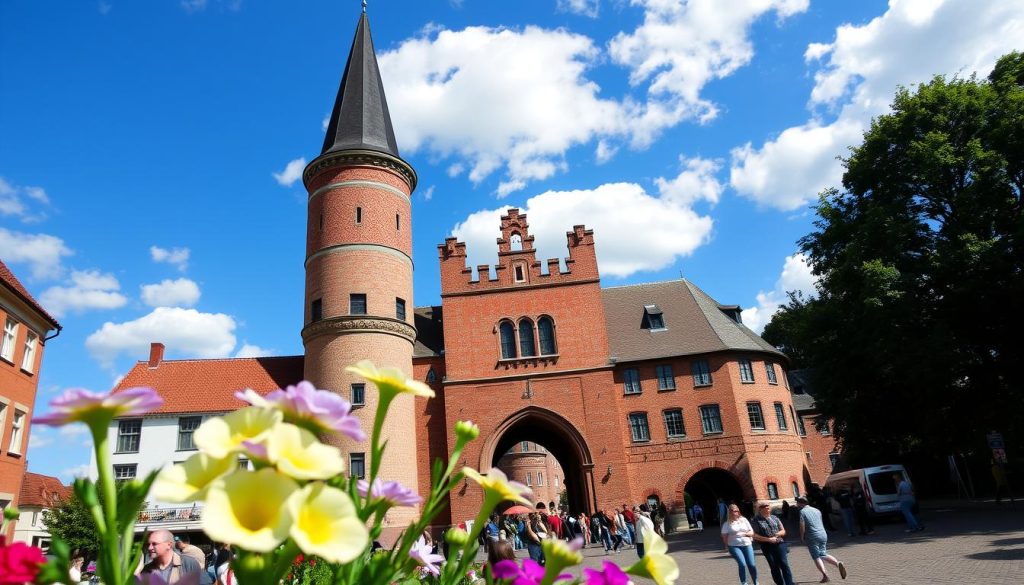
Exploring Lubeck’s sights, the Holstentor is a must-see. This amazing brick gate dates back to the 15th century. It’s the heart of medieval Lubeck’s architecture.
The Holstentor is more than a historical site. It’s a stunning symbol of Lubeck’s past power and wealth. Its unique Gothic design is recognized worldwide, captivating every visitor.
“A gateway that tells the story of an entire city’s rich medieval heritage”
- UNESCO World Heritage site landmark
- Constructed in the 15th century
- Iconic Gothic architectural design
- Museum inside showcasing city history
Inside the Holstentor, a museum brings Lubeck’s medieval past to life. It shows the city’s role in the Hanseatic League and maritime trade. You’ll learn about its original defensive role.
At Holstentorplatz, this attraction has a 4.6 rating from over 5,228 reviews. It’s a key spot for capturing Lubeck’s historic charm.
Historic Churches and Religious Architecture
Lubeck sightseeing shows a stunning view of spiritual buildings that share centuries of stories. The city’s churches are amazing examples of medieval skill and faith. They invite visitors to learn about their deep history.
In Historic Lubeck, you’ll see some of Germany’s most beautiful religious buildings. They amaze and take you back in time.
St. Mary’s Church: A Gothic Masterpiece
St. Mary’s Church is a huge sight in Lubeck, with its Gothic design. Built from 1280-1304, it’s an amazing 335 feet long. It has:
- Soaring spires reaching 407 feet high
- Transept measuring 162 feet tall and 186 feet wide
- Nave height of 127 feet
- Intricate stone carvings and astronomical clock
Lubeck Cathedral: Romanesque and Gothic Blend
Founded in 1173 and finished in 1336, Lubeck Cathedral is a mix of Romanesque and Gothic. It’s a spiritual place that draws in visitors.
| Cathedral Feature | Historical Detail |
|---|---|
| Tower Height | 394 feet |
| Architectural Style | Gothic choir and aisles |
| Original Structure | Latin cross-shaped Romanesque basilica |
Religious Art and Artifacts
Your visit to Lubeck will show you amazing religious items. You’ll see medieval altarpieces, sculptures, and wooden carvings. They show the city’s deep spiritual history.
“In every stone and arch, Lubeck’s churches whisper stories of faith, artistry, and human resilience.” – Local Historian
Every church in Lubeck is a special look into the city’s rich faith and culture. They are key places for history fans and architecture lovers.
Marzipan Paradise: Niederegger and Sweet Traditions
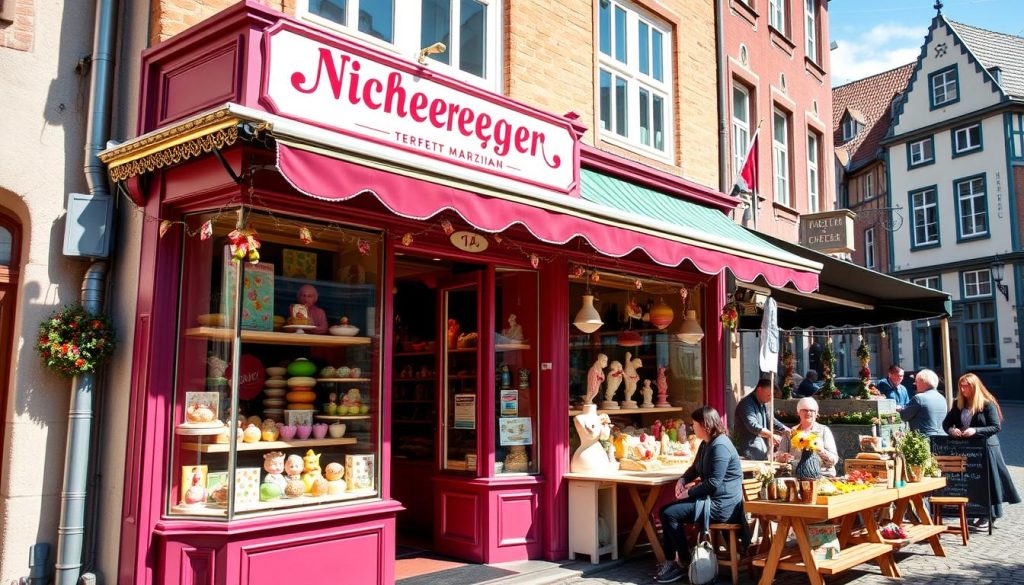
Explore the sweet heart of Lubeck tourism at Niederegger, a legendary marzipan destination since 1806. This iconic confectionery is more than a shop. It’s a culinary landmark that captures the city’s delicious heritage.
Niederegger is a celebration of marzipan craftsmanship. The city claims to have invented marzipan in 1407. When you step inside, you’ll see an incredible world of almond-based artistry.
“Marzipan is not just a treat, it’s the sweet soul of Lübeck” – Local Confectioner
- Sample traditional and innovative marzipan flavors
- Explore the Marzipan Museum upstairs
- Watch skilled artisans create edible masterpieces
- Take home unique marzipan souvenirs
The café offers a delightful experience with an array of marzipan creations. From classic shapes to modern interpretations, each piece tells a story. The museum provides fascinating insights into the history and production of this beloved confection.
Niederegger Marzipan Quick Facts
| Established | Location | Specialty |
|---|---|---|
| 1806 | Lübeck City Center | Artisan Marzipan |
Pro tip: Visit during less crowded hours to fully enjoy the marzipan experience and get personalized attention from the staff.
Cultural Museums and Literary Heritage
Lübeck’s museums take you on a fascinating journey through the city’s rich culture. They showcase the city’s literary and artistic greatness. You’ll learn about famous writers and artists who lived here.
Buddenbrookhaus: Thomas Mann’s Legacy
Step into the world of Nobel Prize winner Thomas Mann at the Buddenbrookhaus. This museum is in Mann’s family home. It brings his famous novel “Buddenbrooks” to life.
2025 marks Mann’s 150th birthday. The museum will have a special exhibit on his political growth from June 6, 2025, to January 18, 2026.
- Explore the restored 19th-century merchant’s house
- Discover intimate details of Thomas Mann’s life
- Learn about the literary significance of “Buddenbrooks”
Günter Grass House Experience
The Günter Grass House is another literary treasure in Lübeck. It showcases Grass’s writing and visual art. The museum has an impressive collection of 1,300 visual artworks by this Nobel laureate.
“Art is a wound turned into light” – Günter Grass
Museum Behnhaus Dragerhaus Collections
Art lovers will be amazed by the Museum Behnhaus Dragerhaus. This 18th-century townhouse has an incredible collection of 19th-century paintings. It includes works by Caspar David Friedrich.
| Museum | Specialty | Notable Feature |
|---|---|---|
| Buddenbrookhaus | Literary Heritage | Thomas Mann’s Family Home |
| Günter Grass House | Visual Arts & Literature | 1,300 Artworks Collection |
| Behnhaus Dragerhaus | 19th-Century Art | Caspar David Friedrich Works |
These museums are the heart of Lübeck’s cultural and artistic legacy. They offer a deep look into the city’s heritage. Whether you love literature or art, these places promise a memorable journey through Lübeck’s rich history.
Maritime History and Harbor Explorations
Explore Lubeck’s rich maritime history on an exciting journey. This city was once a key player in the Hanseatic League. Today, it offers amazing sightseeing along its historic waterfront.
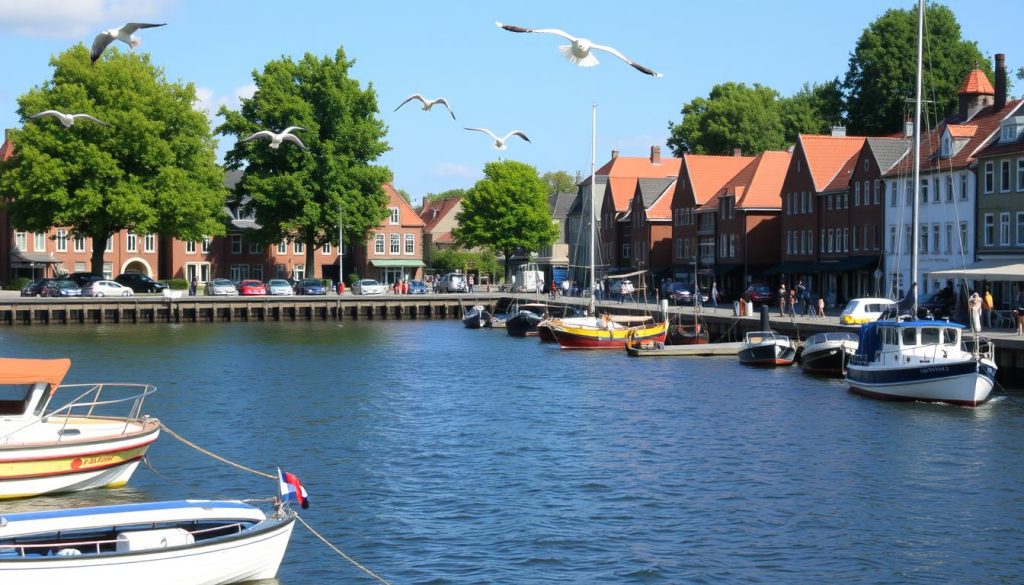
Your adventure starts at the Europäisches Hansemuseum. Here, interactive exhibits bring the city’s trading past to life. You’ll see how Lübeck’s port played a big role in global trade.
“The sea speaks volumes about Lübeck’s historical significance” – Maritime Historian
- Explore the iconic Salzspeicher (salt storehouses)
- Take a panoramic river cruise along the Trave
- Learn about medieval trading routes
- Photograph historic maritime landmarks
Take a boat tour on the Trave River for stunning views of the Old Town. See ships pass by, just like in medieval times. They connected Lübeck to ports all over Europe.
| Maritime Attraction | Experience | Duration |
|---|---|---|
| Europäisches Hansemuseum | Interactive Trading Exhibits | 2-3 hours |
| Trave River Cruise | Panoramic City Views | 1 hour |
| Salzspeicher Tour | Historical Architecture | 45 minutes |
Whether you love history or the sea, Lübeck’s waterfront is unforgettable. It’s a must-see for anyone interested in Germany’s maritime past.
Historic Salt Warehouses and Trading Legacy
Explore the rich maritime heritage of Historic Lubeck. Here, ancient trading routes and stunning architecture tell tales of economic power. The Salzspeicher, or salt warehouses, stand as silent witnesses to Lubeck’s golden age of commerce.
Salzspeicher Architecture: Brick Giants of Trade
The Salzspeicher along the Trave River are a must-see. Their unique stepped gables and strong design make them stand out. Built in the medieval period, they are more than buildings. They are living monuments to a prosperous trading era.
- Unique architectural style with stepped gables
- Positioned strategically along the river
- Preserved examples of Hanseatic commercial buildings
Hanseatic League: Merchants of Northern Europe
Lübeck was the ‘Queen of the Hanseatic League’, a powerful medieval trade confederation. Salt, known as ‘white gold’, was the key commodity that fueled the city’s economy.
“In the realm of trade, Lübeck was not just a city, but an empire of merchants.” – Historical Trader’s Saying
Trading Routes and Global Influence
The salt trade turned Lübeck into a powerful economic center. Merchants carried salt from Lüneburg on the Old Salt Route. This established complex trade networks across Northern Europe.
| Trading Commodity | Significance | Trade Route |
|---|---|---|
| Salt | Primary Economic Driver | Old Salt Route |
| Timber | Construction Material | Baltic Sea Regions |
| Grain | Agricultural Export | Northern European Markets |
Despite World War II air raids in 1942, which damaged about 20% of the Old Town, these warehouses still stand. They are a testament to Lübeck’s resilient spirit and rich trading history.
Traditional Gastronomy and Local Delicacies
Lubeck restaurants take you on a tasty journey through North German food traditions. Your visit to Lubeck isn’t complete without trying the city’s rich food heritage.
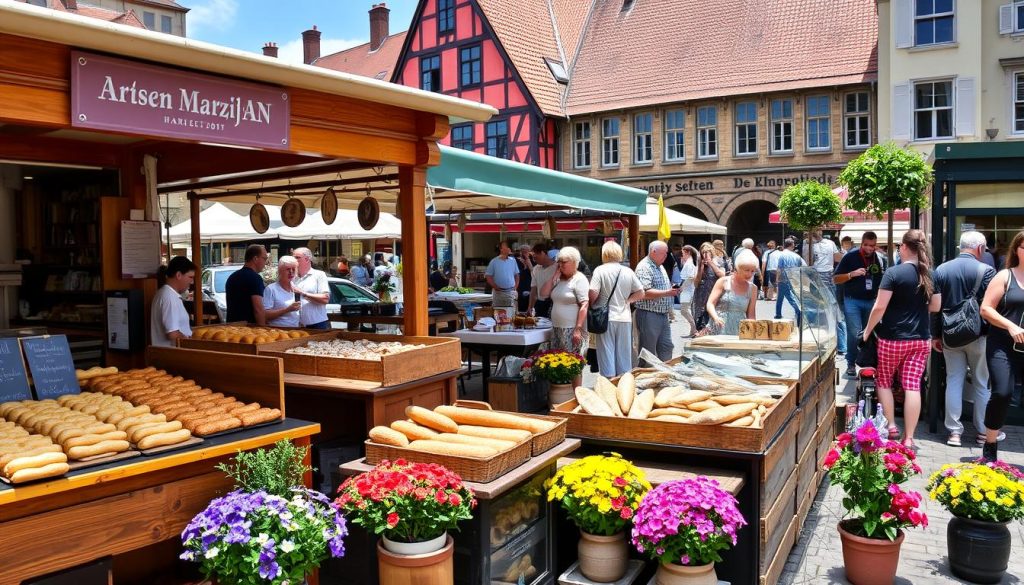
At the legendary Schiffergesellschaft, you’ll find over 500 years of history. This place serves dishes that show off Lubeck’s sea-faring past.
- Try Labskaus, a sailor’s stew with salted meat, potatoes, and herring
- Sample Lübecker Rotspon, a special local red wine
- Enjoy fresh herring dishes that highlight the coastal flavors
“Every bite tells a story of Lubeck’s culinary traditions” – Local Food Enthusiast
Don’t miss the Lübecker Marzipantorte, an almond cake that’s sweet and tart. Local cafes and restaurants offer dishes deeply rooted in regional cooking.
Lubeck restaurants offer a mix of hearty maritime dishes and delicate pastries. Let your taste buds explore the city’s delicious food scene!
Day Trip to Travemunde Beach
Exploring Lubeck tourism leads to a perfect escape at Travemunde Beach. It’s just 20 minutes by train from Lubeck. This Baltic Sea spot offers a cool break from city tours.
Baltic Sea Adventures
Your Lubeck travel guide must include Travemunde’s coastal fun. The beach has many exciting activities for visitors:
- Sailing and windsurfing opportunities
- Swimming in crystal-clear Baltic waters
- Renting traditional strandkorb (beach basket chairs)
- Sunbathing on fine white sandy beaches
Historic Beach Resort Atmosphere
Walk along the historic promenade with elegant 19th-century villas. It feels like stepping back into a traditional German seaside resort.
Waterfront Dining Experiences
Finish your day with seafood at waterfront restaurants. Enjoy fresh local cuisine while watching ships sail to Scandinavia.
“Travemunde offers a delightful coastal escape that perfectly complements your Lubeck adventure.” – Local Travel Guide
| Travel Details | Information |
|---|---|
| Distance from Lubeck | 20 minutes by train |
| Peak Season | July and August |
| Temperature Range | 24-28°C |
Conclusion
Your trip to Lübeck, a UNESCO World Heritage site, is a journey into German culture. This guide shows you a city where old meets new. You’ll see medieval buildings and modern attractions.
Explore the city’s cobblestone streets and famous landmarks. Your adventure will show you the mix of history and today’s life. It’s a place where past and present come together beautifully.
In Lübeck, you can try Niederegger marzipan, see Gothic churches, and enjoy the Altstadt. There’s something for everyone. You can visit museums or try new foods, making your 8-day trip unforgettable.
June to August is the best time to visit for festivals and local culture. But, book your stay early because Lübeck is popular.
Choose from budget-friendly to luxury hotels to make your trip special. Try Holstein Matjes and see old merchant houses. Your visit will be a deep dive into Lübeck’s traditions and modern life.
Remember, Lübeck is more than a place—it’s a story of German heritage. Your guide will help you find hidden spots, taste local foods, and make memories. Get ready for an amazing journey through Lübeck’s timeless beauty.
The above is subject to change.
Check back often to TRAVEL.COM for the latest travel tips and deals.
